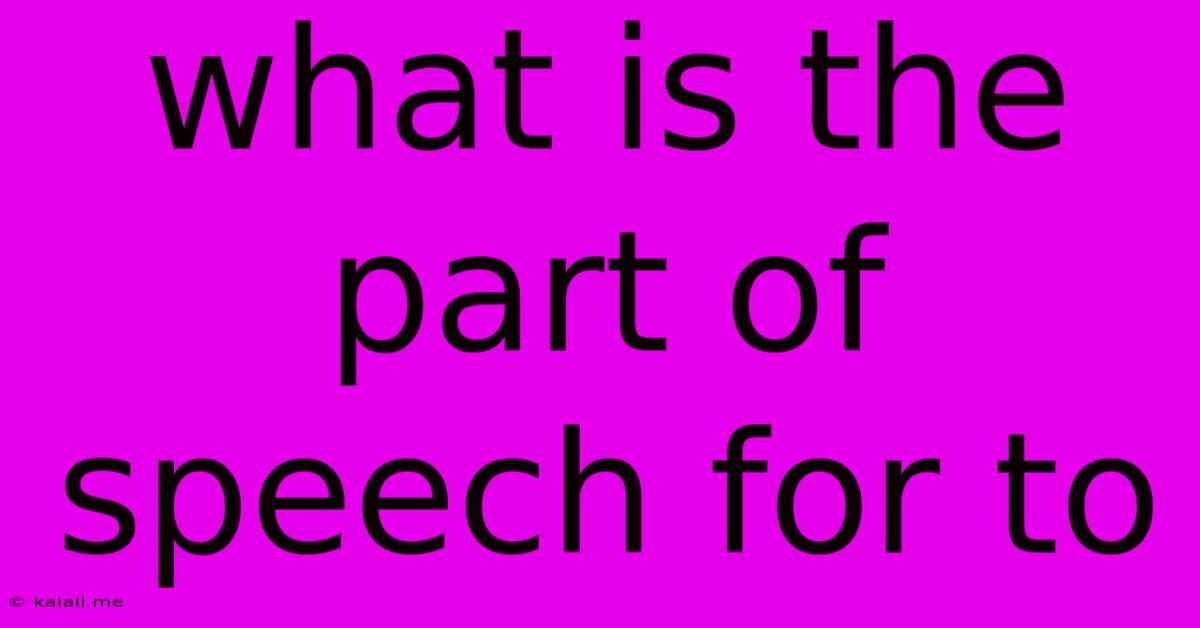What Is The Part Of Speech For To
Kalali
Jun 04, 2025 · 2 min read

Table of Contents
What Part of Speech Is "To"? Unlocking the Mystery of This Versatile Word
The word "to" is a linguistic chameleon, seamlessly shifting its grammatical role depending on its context. It's not easily categorized as a single part of speech, unlike nouns or verbs which hold more consistent functions. Understanding its multifaceted nature is key to mastering English grammar and writing effectively. This article will explore the various functions of "to," clarifying its use as a preposition, an infinitive marker, and occasionally, even as an adverb.
Understanding the Multiple Roles of "To"
While seemingly simple, the word "to" performs several distinct grammatical jobs. Let's delve into each one:
1. "To" as a Preposition
In its most common usage, "to" serves as a preposition. * Definition: PreAPrepositions show the relationship between a noun or pronoun (the object of the preposition) and another word in the sentence. They often indicate location, direction, time, or manner.
-
Examples:
- I went to the store. (Indicates direction)
- She gave the book to him. (Indicates indirect object)
- From nine to five. (Indicates time)
- Similar to the previous example. (Indicates comparison)
In these examples, "to" indicates the direction of movement, the recipient of an action, a time frame, and a comparison, respectively. Note how it connects a noun or pronoun to another word in the sentence, revealing their relationship.
2. "To" as an Infinitive Marker
This is arguably the second most common function of "to." It signals the infinitive form of a verb.
-
Definition: An infinitive is the base form of a verb, often preceded by "to" (e.g., to run, to jump, to think). It's not conjugated to indicate tense or person.
-
Examples:
- I want to eat.
- She needs to study.
- He is planning to travel.
Here, "to" doesn't have a prepositional meaning; it's purely a marker indicating the infinitive verb that follows. The "to" itself doesn't have a meaning independent of the infinitive.
3. "To" as Part of Other Expressions
"To" can also be part of a phrasal verb or idiom, blurring the lines between its functions.
-
Examples:
- To and fro: This is used as an adverb, describing back-and-forth movement.
- To the point: This functions as an adverbial phrase, meaning concise and relevant.
- To boot: This is an idiom, meaning "in addition" or "also".
These instances demonstrate "to" embedded within larger linguistic units, where its function might not be as clearly defined as a preposition or infinitive marker.
Conclusion: The Adaptability of "To"
The versatility of "to" highlights the complexities of English grammar. While generally categorized as a preposition or infinitive marker, its function can depend heavily on the surrounding words and the overall sentence structure. Careful attention to context is vital for accurately identifying and understanding the role of "to" in any given sentence. Mastering the usage of this seemingly simple word is a significant step towards improving one's grammatical accuracy and fluency in English.
Latest Posts
Latest Posts
-
Can I Use A Godox Transmitter With A Neewer Flash
Jun 05, 2025
-
Should I Get A Radon Test With Home Inspection
Jun 05, 2025
-
Why Cant I Type Special Characters In Minecraft
Jun 05, 2025
-
Where Is My Water Pressure Regulator
Jun 05, 2025
-
Can The Sun Be Used To Amplify Radio Waves
Jun 05, 2025
Related Post
Thank you for visiting our website which covers about What Is The Part Of Speech For To . We hope the information provided has been useful to you. Feel free to contact us if you have any questions or need further assistance. See you next time and don't miss to bookmark.